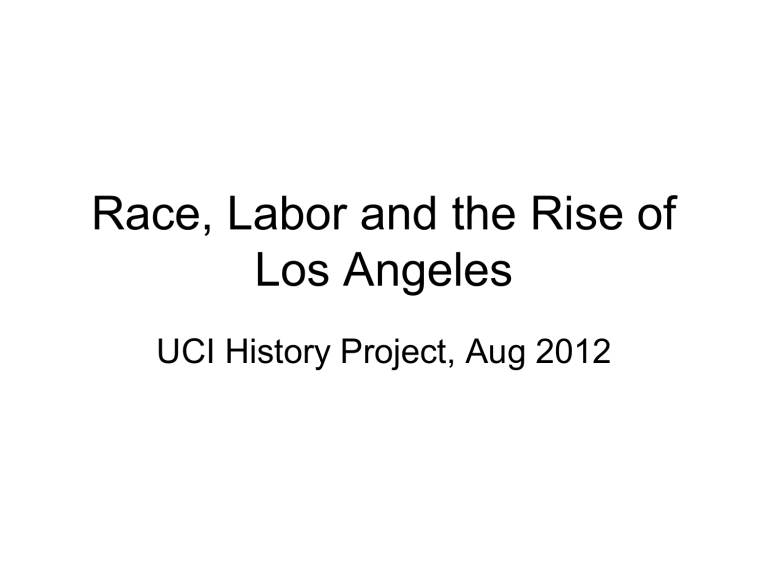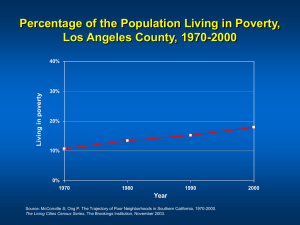Dr. Cohen: "Race, Labor and the Rise of Los Angeles

Race, Labor and the Rise of
Los Angeles
UCI History Project, Aug 2012
1. How was Los Angeles typical/atypical of American cities in the early 20 th century?
2. Who settled in L.A.? Why?
What were the key social and economic transformations in this period? How did these factors shape the region?
3. What is the Spanish Fantasy
Past and how did it shape
L.A.’s development in the early 20 th century? Does it thrive today?
Beyond black and white: LA’s multiculturalism
– L.A., like other cities of U.S. West, was more multicultural than other American cities…
– This multiculturalism
• shapes the growth of CA
• promise of social mobility
– Struggles for power and authority
• Los Angeles as Western frontier
• “Frontier”: a zone of interaction; where multiple groups of people vie for land, power, authority; where they both mix and divide
“Whether in Indian removal or Mormon migration, the theory was the same: the West is where we can get away from each other.
But the workings of history carried an opposite lesson. The West was not where we escaped each other, but where we all met.” (Patricia Limerick, historian of U.S. West)
Who resides in early 20th century Los
Angeles?
• Rapid growth
• Reflect migrations
– From Mexico post-1910
– From U.S. mid-West and East coast, Europe and Asia
– Japanese and Chinese immigrants, Jews from eastern Europe, African
Americans primarily from the U.S. South, and European immigrants
(Austrian-Hungarian, German , British, Italian, Russian, French)
• Push/pull factors
• L.A. central neighborhoods Sonoratown, Chavez Ravine, Chinatown,
"Five Points," Little Tokyo, Boyle Heights, Belvedere, City Terrace, and Watts
– Labeled “foreign districts,” by middle and wealthier classes of Anglos that settled in neighborhoods like Pasadena…
– these neighborhoods were actually ethnically and racially mixed
Vanessa Brandenburg story
• By what route does Brandenburg’s family get from Germany to CA?
• Why do they travel to CA?
• What does this story reveal about migration and the development of the
West in the early 20th century?
African Americans in CA
• Pop in L.A. in 1910, 7599; 1920, 15,579
• Push/pull migration factors
• “half-free conditions”
“By simultaneously holding up the ideal of western opportunity and the realities of western discrimination, black boosters in Los Angeles fostered a regionally distinct language of civil rights activism. Blacks deserved full equal rights not simply because they were American citizens, but also because this was the West, and the
West stood for unparalleled opportunity.” (Doug Flamming, Bound for
Freedom, 129)
Charlotta Bass and the California Eagle
Charlotta Bass and a group of businessmen outside the Eagle
offices, late 1930s, Los Angeles. Throughout its history, the newspaper's editorial and business offices were housed in various locations on or near Central Avenue, the main thoroughfare of Los
Angeles' African American community. The photograph appears to be taken in the late 1930s, when the newspaper's offices were located at 4075 S. Central Avenue. (SCLC)
• This influential, blackowned newspaper ran from
1879 to 1965
• One of the oldest African
American papers in the
West
• Bass operated the paper from 1913 to 1951 when she was “red-baited”
• Devoted to ”the increased participation of Negroes in municipal, state, and national government; the abolition of enforced segregation and all other artificial barriers to the recognition of true merit;
Key economic developments:
1. Industrial Agriculture
• “factories in the field”
• Mass scale, for EXPORT
• Relies on a seasonal, large labor force
– Chinese, Japanese,
Sikh and Filipino workers
– after 1910-1920, mostly
Mexican labor
– “Permanent worker colonies”
– a “southern California brand of Jim Crowism”?
• Influence of grower associations
• Key force in regional boosterism
Filipino citrus workers truck after work, in the
San Fernando Valley in early 1930's. LAPL
2. Urban development
• Railroads
• city building
3. Manufacturing into 1920s, tires, steel, glass, chemicals, aircraft, automobiles, textiles
4. Tourism
5. Oil
New discoveries in the LA basin--1920s
– Huntington Beach, Whittier, Long Beach
– In 1920s, CA #1 producer of crude oil production in U.S.
(more than TX and Oklahoma)
– Aligns with new developments in oil refining & auto production
– By 1930, oil refining was CA’s largest industry
– Impact (population, econ boom; car culture; car tourism)
Workmen remove trees and shrubbery from in front of W.B. Conger's home at 652
Aerick Street, in Inglewood, so the house can be moved away and a derrick erected in its place. Many such residences are being removed as rapidly as the job can be done, to allow derrick materials and machinery to be erected by George F. Getty,
Inc. Getty is having 15 houses moved from lots which he has leased. Photo dated
September 30, 1929 (LAPL)
Home of Mr. and Mrs. Frank Neace at 634 Aerick Street, in Inglewood, is boosted up on trestle work and ready to be hauled away to make room for a well. Many such residences are being removed as rapidly as the job can be done, to allow derrick materials and machinery to be erected by George F. Getty, Inc. Getty, whose No. 12 well is on production, is having 15 houses moved from lots which he has leased. Photo dated September 30, 1929.
Signal Hill Oil Field, 1930
(LAPL photo archive)
• L.A.’s white elite (Anglo industry leaders, real estate magnates and middle-class reformers) attempt to control city development via…
– Through policies such as the establishment of a "no speech" zone, and Criminal Syndicalism Act in 1919 effectively banished street speaking from the city's political culture throughout the 1920s
– Re-zoning laws; Eg: Central L.A. neighborhoods for industry
– Boosterism--promoting the region by re-defining its image and history
Selling Southern California
• The California Fruit Growers
Exchange, the Southern
Pacific, real estate magnates, chambers of commerce launch a national advertising campaign to promote CA’s product and to attract investors, settlers, and tourists.
•
Look at the following advertisements: What images and themes recur? How do these images compare with the social history of the region? How do these images define a regional identity?
Crate label for "Sonny" Orange County Valencias, Olive Hillside Groves Inc., Olive,
California Contributing Institution: Orange Public Library via calisphere. Olive Hillside Groves was located on Orange-Olive Road, by the railroad tracks, and was the first packing house founded in
Olive, on September, 1914. In December of 1927, it was completely destroyed by fire and later rebuilt on the same site, continuing operation until around 1960.
Orange "You'll like it"
advertising brochure cover, Orange,
California,1927
Created by the
Orange Chamber of
Commerce, the 12page brochure contains descriptions and photographs of many of the attractions for living and visiting the city of Orange,
California.
Look closer:
Spanish Fantasy Past
• Coined by historian Carey McWilliams
• “Master narrative in the selling of Los Angeles”
• So the story goes…
• ascribed Spanish lineage to the ruling-class
Californios w ho had settled CA
• Recast the relationship between Spanish priest and
Native Aemricans as paternalistic and benevolent, rather than filled with conflict and violence and
• obscured the decline of the Californios who had often lost everything after the American takeover
• Ascribed Mexicans in LA to past; erased from present
• A usable past
“Spanish Fantasy Past” & Mission Revivalism
1st Motel, Located in San Luis Obispo, CA off the U.S. 101
Olvera Street, before tourism project (LAPL)
Overa Street, 1930s
Concluding thoughts…
• L.A.’s early history can be used to teach many things
– highlights concept of frontier
• Of struggles for power and authority in the
West
– Multiculturalism in the West
– Of the interplay between myths and/or popular understandings of history and social history
– And to come back to where we began: of how dominance of an Anglo, middle-class was neither inevitable nor uncontested
Teaching Resources
• Calisphere http://www.calisphere.universityofcalifornia.edu/
• We Are California http://weareca.org
• USC Regional History Digital Library http://www.usc.edu/libraries/archives/arc/libraries/regional/index.html
• LAPL photo collection http://www.lapl.org/











